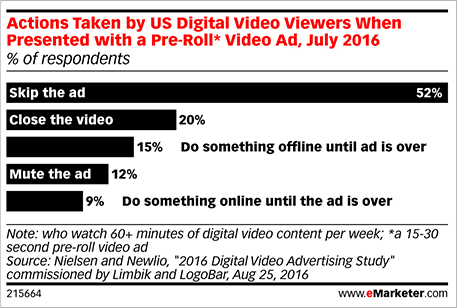We’re in the “Golden Age” of television: a rise in the quality and volume of short-form video content, aided by the emergence of streaming platforms like YouTube and Netflix. As this new age reverberates across the advertising world, brands have rushed to allocate more than half their digital budgets to video. In 2017, video advertising’s 67% growth will outpace all other areas of digital ad spending except mobile, according to data from J.P. Morgan.
Unfortunately for brands, as often happens when ad spending drastically increases across a single medium, viewers are now systematically tuning out video ads. Surveys show 52% of viewers skip the ad when presented with “pre-roll video,” a promotional message that plays before their selected content.

So how can we avoid throwing dollars away on digital video that often isn’t even reaching the intended audience? Improving the quality of ads is the most obvious answer, but that’s easier said than done.
Some important lessons can be learned from recent trends in television; specifically, a popular formula being applied to title intro sequences. After all, the “opening credits”—a necessary evil that’s typically irrelevant to the end-viewer—isn’t so different from a pre-roll ad, right? I used to simply hit “fast-forward” through the credits, eager to binge-watch episode after episode of my favorite show. But recent, critically-acclaimed series such as Game of Thrones, Westworld, and True Detective have featured can’t-miss title sequences that are just as captivating as the dramas themselves.
Here’s the formula for a successful intro sequence, and what we can learn from it:
1. Quickly capture attention through contextual relevance: Gone are the days of catchy song intros playing in the background while actors’ headshots dance across the screen. Today’s arty, thought-provoking intro sequences take their own role in telling the story. The intro for Game of Thrones features a sprawling, living CGI map with the show’s kingdoms and cities rising by gears, bricks, and building blocks. It’s a visually impressive way to establish the show’s themes of power struggles and war games. And it’s slightly differently each time, ending with the kingdom that will dominate the upcoming episode.
“Game of Thrones” Main Titles from Elastic on Vimeo.
When HBO premiered its even higher-budget show Westworld, it used an eerily similar dramatic intro sequence (produced by the same talented group of filmmakers, Elastic), to send its dedicated Game of Thrones fans a message: you will like this show, too. The Westworld intro features similar close-up, CGI shots (this time, of robots being assembled, synthetic tendon-by-tendon). It also alludes to the identity conflicts the show will explore, starkly contrasting unskinned robots in milky placenta with scenes of a dusty western landscape. By mimicking these basic, mechanical elements, HBO subtly wove connections in viewers’ minds between the two fantasy shows, hoping to capitalize on its previous success and set high expectations for the content.
HBO Westworld – Main Titles from Elastic on Vimeo.
While the relationship between a TV show’s intro sequence and its plotline is obviously much more tightly intertwined than a video ad and the content it appears with, the success of this approach still speaks to an important broader trend. The number one reason viewers report skipping digital video ads? “They’re not relevant to me.” More and more brands are using 3rd party data or programmatic placements to ensure they’re at least targeting audiences that will be interested in their content or products—but an important next step could be pairing pre-roll video ads that even more closely complement the main content chosen by the viewer.
2. Set an emotional mood through imagery and audio: One commonality between new-age intro sequences is that they manage to tell an emotional story with no actors in sight. While Game of Thrones and Westworld did this through mechanical world-building, the popular first season of True Detective takes on a physical place (Louisiana) as the main character of its intro sequence, greeting viewers with desaturated, moody images of southern desolation and loneliness. Slow motion close-ups of actors’ silhouettes fade in and out over scenes of pumping refineries, religious fervor, and bleak sexuality. Long stretches of highway, sparsely populated with trudging vehicles, run north to south like veins over the landscape. The setting, mood, and general themes are all laid out in a tantalizingly emotive visual stream, atop a low, haunting country song.
HBO “True Detective” Main Title from Elastic on Vimeo.
More recently, Netflix’s original series Making A Murderer shows bleak de-saturated rural landscapes, interspersed with the same silhouettes, bare trees, snaking highways, and even free-floating flames set to the tune of dramatic music, hinting at the intensity of the subject.
3. Invest in high-quality production: There’s no way around it—these crisp and mesmerizing intro sequences are as expensive as they look. The hi-tech CGI animations, intricate design elements, and original musical scores can be cost-prohibitive, even for Hollywood budgets. But even networks with much smaller budgets than HBO’s are focusing a higher percentage of spend on title sequences, hoping to boost the overall perception of a show’s production value. Starz, for example, hired Elastic to produce an abstract, otherworldly introduction to American Gods that pits it as a serious and edgy prestige on par with HBO’s costlier fare. And The Crown, a much quieter, serious endeavor of royal history, also sports a title sequence by Elastic, featuring a hypnotic close-up of a CGI gold crown melting and flowing itself into solid form.
The Crown – Main Title Sequence from Elastic on Vimeo.
Through this formula, TV studios have transformed what was previously a droll annoyance to viewers into a repeatable opportunity to engage them. Before video ad completion rates dwindle into the single digits, digital marketers should be testing more creative approaches like this. If digital video can create emotional connections through context and high-quality design that sets the stage for a bigger brand story, our industry could even embark on its own Golden Age.